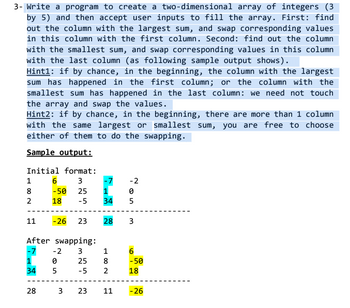
Write a program to create a two-dimensional array of integers (3 by 5) and then accept user inputs to fill the array. First: find out the column with the largest sum, and swap corresponding values in this column with the first column. Second: find out the column with the smallest sum, and swap corresponding values in this column with the last column (as following sample output shows). Hint1: if by chance, in the beginning, the column with the largest sum has happened in the first column; or the column with the smallest sum has happened in the last column: we need not touch the array and swap the values. Hint2: if by chance, in the beginning, there are more than 1 column with the same largest or smallest sum, you are free to choose either of them to do the swapping. (Use Java coding language).

The question is to write JAVA code for the given problem.
Step by stepSolved in 2 steps with 1 images

- Statistics are often calculated with varying amounts of input data. Write a program that takes any number of non-negative integers as input, and outputs the max and average, respectively. Output the max and average with two digits after the decimal point. Ex: If the input is: 14.25 25 0 5.75 the output is: 25.00 11.25 461710 3116374.qx3zqy7 LAB ACTIVITY 6.7.1: LAB: Varied amount of input data 0/10arrow_forwardWrite a program that reads a list of 10 integers, and outputs those integers in reverse. For coding simplicity, follow each output integer by a space, including the last one. Then, output a newline. Ex: If the input is 2 4 6 8 10 12 14 16 18 20, the output is: 20 18 16 14 12 10 8 6 4 2 To achieve the above, first read the integers into an array. Then output the array in reverse. IN CORAL Please!arrow_forwardWrite a program that takes in four positive integers and outputs the number of odd numbers. (Hint: use the modulo operator to determine if a number is odd) Ex: If the input is: 1 2 3 4 the output is: 2 Below is my code so far and I'm getting back unexpected EOF while parsing. I can't figure out what I'm doing wrong. odd_number=[]number_1=int(input())number_2=int(input())number_3=int(input())number_4=int(input())if number_1%2!=0: odd_number.append(number_1)else: passif number_2%2!=0: odd_number.append(number_2)else: passif number_3%2!=0: odd_number.append(number_3)else: passif number_4%2!=0: odd_number.append(number_4)else: passprint(len(odd_number)arrow_forward
- Use Java language and the last digit of ID is a 7arrow_forwardCAN THIS PLEASE BE DONE In PYTHON? Input a list of employee names and salaries and store them in parallel arrays. End the input with a sentinel value. The salaries should be floating point numbers Salaries should be input in even hundreds. For example, a salary of 36,510 should be input as 36.5 and a salary of 69,030 should be entered as 69.0. Find the average of all the salaries of the employees. Then find the names and salaries of any employee who's salary is within 5,000 of the average. So if the average is 30,000 and an employee earns 33,000, his/her name would be found. Display the following using proper labels. Save your file using the naming format LASTNAME_FIRSTNAME_M08 FE. Turn in your file by clicking on the Start Here button in the upper right corner of your screen. 1.Display the names and salaries of all the employees. 2. Display the average of all the salaries 3. Display all employees that are within 5,000 range of the average.arrow_forwardWrite a program to accept 10 positive and negative values in an integer array. Program would shift all negative values to the left side and all positive values to the right side of the array without sorting them. Use Java coding Language.arrow_forward
- Write a program that reads a list of integers from input into an array and outputs "yes" if the list is sorted in ascending order between two provided positions. Otherwise, output "no". The first input specifies the number of items in the list. The next set of inputs is the list. The last two inputs are the start and end positions (inclusive). Assume the list contains less than 20 integers and position 1 is the first element. Ex: If the input is: 8 5 6 7 4 3 2 1 0 1 3 the output is: yes Ex: If the input is: 6 1 2 3 4 5 2 4 6 the output is: noarrow_forwardWrite a program that outputs all the integers between 100 and 1000 (inclusive), that are divisible by 5 and also 6. (This means start at 100 and go up to 1000, but only output integers that are divisible by both 5 and 6.) Remember what "divisible" means - if a number is divisible by 5, there is no remainder when you divide it by 5. If a number is divisible by 6, there is no remainder when you divide it by 6. In javaarrow_forward
 Database System ConceptsComputer ScienceISBN:9780078022159Author:Abraham Silberschatz Professor, Henry F. Korth, S. SudarshanPublisher:McGraw-Hill Education
Database System ConceptsComputer ScienceISBN:9780078022159Author:Abraham Silberschatz Professor, Henry F. Korth, S. SudarshanPublisher:McGraw-Hill Education Starting Out with Python (4th Edition)Computer ScienceISBN:9780134444321Author:Tony GaddisPublisher:PEARSON
Starting Out with Python (4th Edition)Computer ScienceISBN:9780134444321Author:Tony GaddisPublisher:PEARSON Digital Fundamentals (11th Edition)Computer ScienceISBN:9780132737968Author:Thomas L. FloydPublisher:PEARSON
Digital Fundamentals (11th Edition)Computer ScienceISBN:9780132737968Author:Thomas L. FloydPublisher:PEARSON C How to Program (8th Edition)Computer ScienceISBN:9780133976892Author:Paul J. Deitel, Harvey DeitelPublisher:PEARSON
C How to Program (8th Edition)Computer ScienceISBN:9780133976892Author:Paul J. Deitel, Harvey DeitelPublisher:PEARSON Database Systems: Design, Implementation, & Manag...Computer ScienceISBN:9781337627900Author:Carlos Coronel, Steven MorrisPublisher:Cengage Learning
Database Systems: Design, Implementation, & Manag...Computer ScienceISBN:9781337627900Author:Carlos Coronel, Steven MorrisPublisher:Cengage Learning Programmable Logic ControllersComputer ScienceISBN:9780073373843Author:Frank D. PetruzellaPublisher:McGraw-Hill Education
Programmable Logic ControllersComputer ScienceISBN:9780073373843Author:Frank D. PetruzellaPublisher:McGraw-Hill Education





